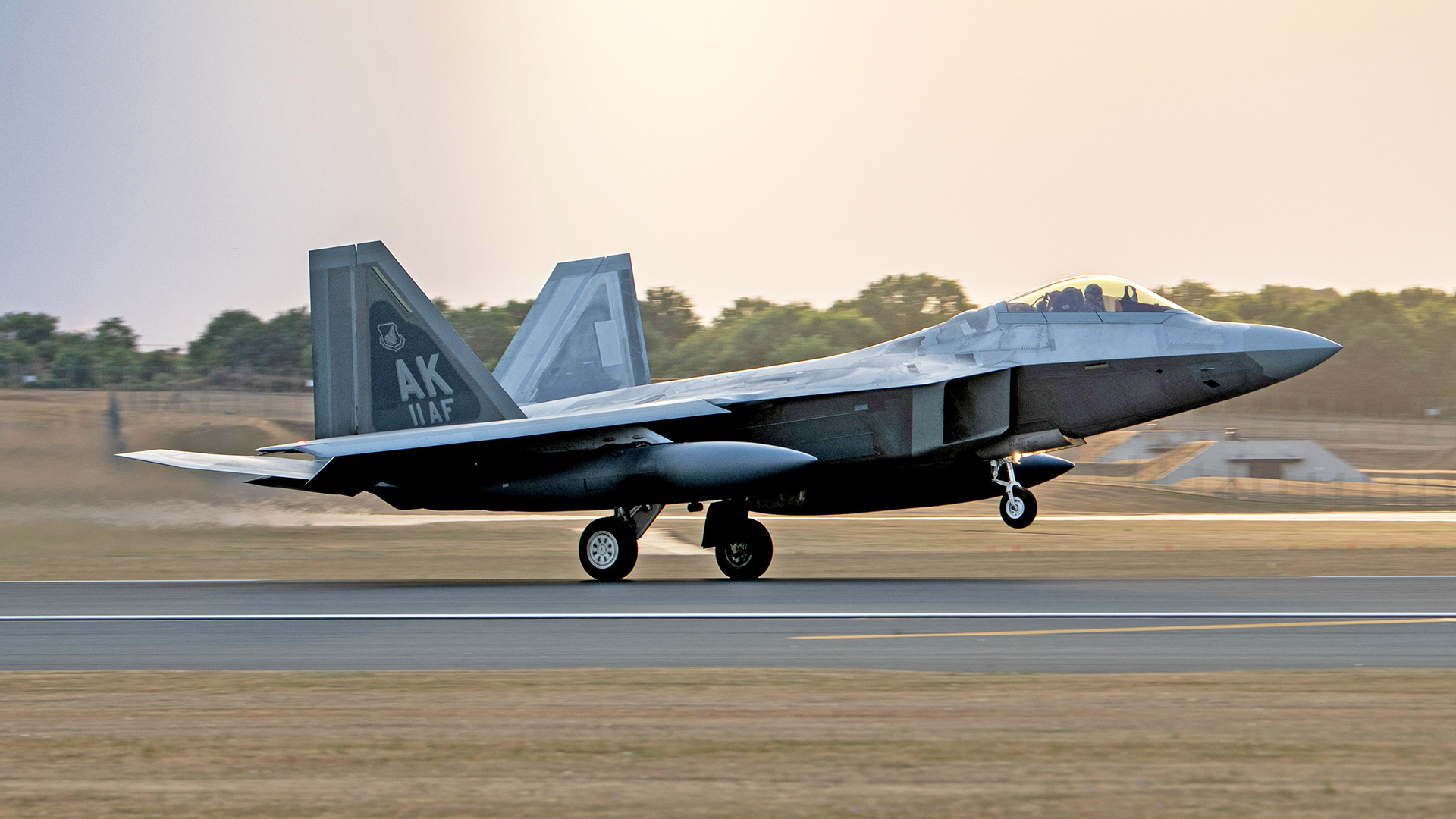As Russia threatens “tougher action” against the U.S. if it continues arming Ukraine, six U.S. Air Force F-22 Raptor stealth fighters have arrived in England on their way to Poland. This deployment is unprecedented for the world’s most capable air-to-air fighter. F-22s have visited Poland before, but it was only two of them on what was more of a quick goodwill and reassurance mission than a deployment.
The fifth-generation fighter jets are from the 90th Fighter Squadron, part of the Air Force’s 3rd Wing at Joint Base Elmendorf-Richardson, Alaska, the flying branch announced in a media release Wednesday. They arrived at RAF Lakenheath in England on Tuesday, en route to the 32nd Tactical Air Base in Łask, Poland. Once deployed, the unit will be referred to as the 90th Expeditionary Fighter Squadron and will be supporting the NATO Air Shielding mission.

The NATO Air Shielding mission brings together allied air and surface-based air and missile defense units under NATO’s command and control.
That mission “will provide a near seamless shield from the Baltic to Black Seas, ensuring NATO Allies are better able to safeguard and protect Alliance territory, populations and forces from air and missile threat,” the Air Force said in its release.
It’s part of an increased effort by the U.S. and its NATO partners to boost the aerial presence in the region, something that began to tick up long before Russia invaded Ukraine in a failed effort to dissuade Vladimir Putin from taking action and to bolster NATO’s eastern flank if he did. But since then, 120 jets have been placed on high alert, retired Air Force Gen. Tod Wolters, then-commander of U.S. European Command and Supreme Allied Commander Europe, told a meeting of NATO defense chiefs in May.
There has been “a 50% increase of fighter jets patrolling the skies,” he said.
Poland, meanwhile, has become a staging ground for foreign arms and other military supplies heading into Ukraine, and has provided various weapons like tanks and howitzers itself. The Polish government is also working to bolster its own defenses, purchasing U.S. Abrams main battle tanks and, recently, tanks, howitzers, and aircraft from South Korea.
As a result of the influx of arms to Ukraine, Konstantin Gavrilov, head of Russia’s delegation on arms control in Vienna, threatened “tougher actions” against the west, according to the Kyiv Independent.
These are just the latest U.S. fighters to arrive in Poland.
Marine F/A-18 Hornets from the 2nd Marine Aircraft Wing (MAW) are also at Łask Air Base, “deployed to enhance NATO’s capabilities in Eastern Europe at the invitation” of Poland, according to that service.
Poland is strategically located, sharing long borders with Belarus and Ukraine. Its airspace is now defended by Poland’s own F-16s and MiG-29s, assisted by U.S. fighters, including F-35As flying from Spangdahlem in Germany. E-3 AWACS aircraft have also been a constant fixture in the region to support NATO fighter flights near the Ukraine and Belarus borders, as are KC-135 tankers to support these operations.
NATO says it has been “heavily bolstering its eastern flank since the turn of the year in response to Russia’s military build-up on Ukraine’s border and eventual invasion.”
“NATO air forces have bolstered their presence in the eastern part of the Alliance helping to shield NATO against any aggression,” said Headquarters Allied Air Command Chief of Staff, Major General Jörg Lebert in a May release. “Several dozen fighter jets are on alert at any time to respond to possible airspace violations and to deter aggression.”

In February, fully armed Air Force F-15C and F-15D Eagle fighter jets arrived at Lask to take part in a mission designed to “enhance NATO’s collective defense posture,” as well as support the permanent Baltic Air Policing (BAP) mission in the region. Those aircraft are now gone, but the stream of U.S. fighters taking up the mission has not ceased.
Wednesday’s Air Force release about the F-22s heading to Poland touts the capabilities the Raptor brings to the mission, saying it has the “ability to provide lethality and survivability against any emerging high-end threats. The Raptor performs both air-to-air and air-to-ground missions allowing full realization of operational concepts vital to the 21st century Air Force.”
The release extolling the Raptor also comes as the Air Force is looking to retire more than two dozen of the oldest examples of the stealthy jets, as we discussed in great detail here.

However, that plan may get scrambled. Both the House and Senate Armed Services Committees, which oversee funding and oversight of the Pentagon on behalf of Congress, are trying to make the Air Force not only keep, but upgrade the 33 older-model F-22s that it had wanted to discard under its 2023 budget proposal plans.
The future of the Raptor is something we’ve discussed in the past, reflecting on the pros and cons of a smaller, more capable Raptor force. There is an argument to be made to invest in the most effective F-22s, and make them better still, especially with the Next Generation Air Dominance (NGAD) program on the horizon and F-35A numbers swelling. On the other hand, the F-22 is already struggling for availability, with a mission-capable rate of around 50% in peacetime.
Beyond that, there are only about 125 ‘combat-coded’ Raptors in the inventory at any given time. Tacking on the training requirement will only exacerbate those issues. Plus, having some kind of reserve force for possible conflict scenarios could be a major advantage.
Case in point, these F-22s came all the way from Alaska to support this mission. In the past, European Raptor deployments were supported by stateside Langley AFB and Tyndall AFB units.
Regardless, the world’s most capable air-to-air fighter is now headed to an allied country that borders a country that Russia has invaded. The message is very clear.
Contact the author: howard@thewarzone.com

